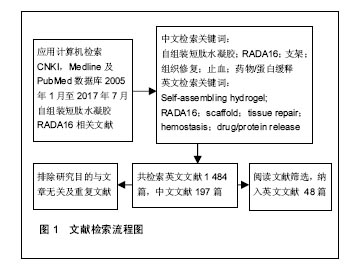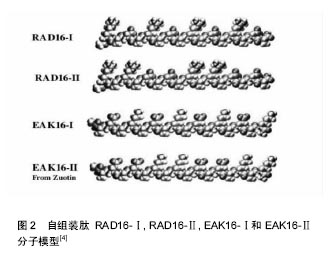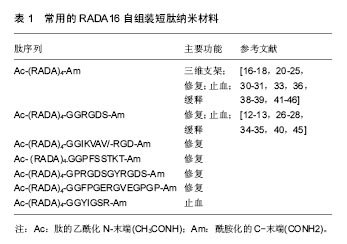| [1]Li YJ, Chung EH, Rodriguez RT, et al. Hydrogels as artificial matrices for human embryonic stem cell self-renewal. J Biomed Mater Res A. 2006;79(1):1-5.[2]Lutolf MP, Gilbert PM, Blau HM. Designing materials to direct stem-cell fate. Nature. 2009;462(7272):433-441.[3]Zhang Z, Li F, Tian H, et al. Differentiation of adipose-derived stem cells toward nucleus pulposus-like cells induced by hypoxia and a three-dimensional chitosan- alginate gel scaffold in vitro. Chin Med J (Engl). 2014;127(2):314-321.[4]Zhao X, Zhang S, Spirio L. PuraMatrix: self-assembling eptide nanofiber scaffolds. Tayor Francis: Boca Raton. 2005. [5]De la Rica R, Matsui H. Applications of peptide and protein-based materials in bionanotechnology. Chem Soc Rev. 2010;39(9):3499-3509.[6]Gelain F, Bottai D, Vescovi A, et al. Designer self-assembling peptide nanofiber scaffolds for adult mouse neural stem cell 3-dimensional cultures. PLoS One. 2006;1:e119.[7]Liu J, Song H, Zhang L,et al. Self-assembly-peptide hydrogels as tissue-engineering scaffolds for three-dimensional culture of chondrocytes in vitro. Macromol Biosci. 2010;10(10):1164-1170.[8]Loo Y, Zhang S, Hauser CA. From short peptides to nanofibers tomacromolecular assemblies in biomedicine. Biotechnol Adv. 2012;30(3): 593-603.[9]Yokoi H, Kinoshita T, Zhang S. Dynamic reassembly of peptide RADA16 nanofiber scaffold. Proc Natl Acad Sci U S A. 2005;102(24): 8414-8419.[10]Tian X, Sun F, Zhou XR, et al. Role of peptide self-assembly in antimicrobial peptides. J Pept Sci. 2015;21(7):530-539.[11]Horii A, Wang X, Gelain F, et al. Biological designer self-assembling peptide nanofiber scaffolds significantly enhance osteoblast proliferation, differentiation and 3-D migration. PLoS One. 2007;2(2):e190. [12]Sun Y, Li W, Wu X, et al. Functional self-assembling peptide nanofiber hydrogels designed for nerve degeneration. ACS Appl Mater Interfaces. 2016;8(3):2348-2359.[13]Zhang N, Luo Y, He L, et al. A self-assembly peptide nanofibrous scaffold reduces inflammatory response and promotes functional recovery in a mouse model of intracerebral hemorrhage. Nanomedicine. 2016;12(5):1205-1217.[14]Huang W, Lu L, Shao X, et al. Anti-melanoma activity of hybrid peptide P18 and its mechanism of action. Biotechnol Lett. 2010;32(4):463-469.[15]Kim Y, Stolarska MA, Othmer HG. The role of the microenvironment in tumor growth and invasion. Prog Biophys Mol Biol. 2011;106(2):353-379.[16]Kakiuchi Y, Hirohashi N, Murakami-Murofushi K. The macroscopic structure of RADA16 peptide hydrogel stimulates monocyte/macrophage differentiation in HL60 cells via cholesterol synthesis. Biochem Biophys Res Commun. 2013;433(3):298-304.[17]Ni N, Hu Y, Ren H, et al. Self-assembling peptide nanofiber scaffolds enhance dopaminergic differentiation of mouse pluripotent stem cells in 3-dimensional culture. PLoS One. 2013;8(12):e84504.[18]Jasty S, Suriyanarayanan S, Krishnakumar S.Influence of self-assembling peptide nanofibre scaffolds on retinal differentiation potential of stem/progenitor cells derived from ciliary pigment epithelial cells. J Tissue Eng Regen Med. 2017;11(2):509-518.[19]Cavalcanti BN, Zeitlin BD, Nor JE. A hydrogel scaffold that maintains viability and supports differentiation of dental pulp stem cells. Dent Mater. 2013;29(1):97-102.[20]Liu X, Wang X, Wang X,et al. Functionalized self-assembling peptide nanofiber hydrogels mimic stem cell niche to control human adipose stem cell behavior in vitro. Acta Biomater. 2013;9(6):6798-6805.[21]Wu G, Pan M, Wang X, et al. Osteogenesis of peripheral blood mesenchymal stem cells in self assembling peptide nanofiber for healing critical size calvarial bony defect. Sci Rep. 2015.[22]Gao XR, Xu HJ, Wang LF, et al. Mesenchymal stem cell transplantation carried in SVVYGLR modified self-assembling peptide promoted cardiac repair and angiogenesis after myocardial infarction. Biochem Biophys Res Commun. 2017.[23]Mi K, Wang G, Liu Z, et al. Influence of a self-assembling peptide, RADA16, compared with collagen I and Matrigel on the malignant phenotype of human breast-cancer cells in 3D cultures and in vivo. Macromol Biosci. 2009;9(5):437-443.[24]Mi K, Xing Z. CD44(+)/CD24(-) breast cancer cells exhibit phenotypic reversion in three-dimensional self-assembling peptide RADA16 nanofiber scaffold. Int J Nanomedicine. 2015;10:3043-3053.[25]Quintiliano K, Crestani T, Silveira D, et al. Neural differentiation of mesenchymal stem cells on scaffolds for nerve tissue engineering applications. Cell Reprogram. 2016;18(6):369-381.[26]Wu X, He L, Li W, et al. Functional self-assembling peptide nanofiber hydrogel for peripheral nerve regeneration. Regen Biomater. 2017;4(1):21-30.[27]Nune M, Krishnan UM, Sethuraman S. PLGA nanofibers blended with designer self-assembling peptides for peripheral neural regeneration. Mater Sci Eng C Mater Biol Appl. 2016; 62:329-337. [28]Nune M, Subramanian A, Krishnan U, et al. Self-assembling peptide nanostructures on aligned poly (lactide-co-glycolide) nanofibers for the functional regeneration of sciatic nerve. Nanomedicine (Lond). 2017;12(3):219-235. [29]Shi W, Huang CJ, Xu XD, et al. Transplantation of RADA16-BDNF peptide scaffold with human umbilical cord mesenchymal stem cells forced with CXCR4 and activated astrocytes for repair of traumatic brain injury. Acta Biomater. 2016;45:247-261.[30]Liao YS, Deng L, Gao XQ, et al. Effects of self-assembling peptide RADA16-? hydrogel on neural differentiation of bone marrow mesenchymal stem cells. Adv Mater Res. 2014; 998:238-242.[31]Wu M, Ye Z, Zhu H, et al. Self-assembling peptide nanofibrous hydrogel on immediate hemostasis and accelerative osteosis. Biomacromolecules. 2015;16(10): 3112-3118.[32]Li Z, Hou T, Luo F, et al. Bone marrow enriched graft, modified by self- assembly peptide, repairs critically-sized femur defects in goats. Int Orthop. 2014;38(11):2391-2398.[33]He B, Ou Y, Chen S, et al. Designer bFGF-incorporated d-form self-assembly peptide nanofiber scaffolds to promote bone repair. Mater Sci Eng C Mater Biol Appl. 2017;74: 451-458.[34]Wang X, Wang J, Guo L, et al. Self-assembling peptide hydrogel scaffolds support stem cell-based hair follicle regeneration. Nanomedicine. 2016;12(7):2115-2125.[35]Bradshaw M, Ho D, Fear MW, et al. Designer self-assembling hydrogel scaffolds can impact skin cell proliferation and migration. Sci Rep. 2014;4:6903.[36]Takeuchi T, Bizenjima T, Ishii Y, et al. Enhanced healing of surgical periodontal defects in rats following application of a self-assembling peptide nanofibre hydrogel. J Clin Periodontol. 2016;43(3):279-288.[37]Akiyama N, Yamamoto-Fukuda T, Takahashi H, et al. In situ tissue engineering with synthetic self-assembling peptide nanofiber scaffolds, PuraMatrix, for mucosal regeneration in the rat middle-ear. Int J Nanomedicine. 2013;8:2629-2640.[38]Ellis-Behnke RG, Liang YX, Tay DK, et al. Nano hemostat solution: immediate hemostasis at the nanoscale. Nanomedicine. 2006;2(4):207-215.[39]Wang T, Zhong X, Wang S, et al. Molecular mechanisms of RADA16-1 peptide on fast stop bleeding in rat models. Int J Mol Sci. 2012;13(11):15279-15290. [40]Cheng TY, Wu HC, Huang MY, et al. Self-assembling functionalized nanopeptides for immediate hemostasis and accelerative liver tissue regeneration. Nanoscale. 2013; 5(7): 2734-2744. [41]Xu FF, Wang YC, Sun S, et al. Comparison between self-assembling peptide nanofiber scaffold (SAPNS) and fibrin sealant in neurosurgical hemostasis. Clin Transl Sci. 2015; 8(5): 490-494.[42]Davis ME, Hsieh PC, Takahashi T, et al. Local myocardial insulin-like growth factor 1 (IGF-1) delivery with biotinylated peptide nanofibers improves cell therapy for myocardial infarction. Proc Natl Acad Sci U S A. 2006;103(21):8155- 8160.[43]Liu J, Zhang L, Yang Z, et al. Controlled release of paclitaxel from a self-assembling peptide hydrogel formed in situ and antitumor study in vitro. Int J Nanomedicine. 2011;6: 2143-2153.[44]Briuglia ML, Urquhart AJ, Lamprou DA. Sustained and controlled release of lipophilic drugs from a self-assembling amphiphilic peptide hydrogel. Int J Pharm. 2014;474(1-2): 103-111.[45]Zhou A, Chen S, He B, et al. Controlled release of TGF-beta 1 from RADA self-assembling peptide hydrogel scaffolds. Drug Des Devel Ther. 2016;10:3043-3051.[46]Li R, Pang Z, He H, et al. Drug depot-anchoring hydrogel: a self-assembling scaffold for localized drug release and enhanced stem cell differentiation. J Control Release. 2017; 261:234-245.[47]Huebsch N, Mooney DJ. Inspiration and application in the evolution of biomaterials. Nature. 2009;462(7272):426-432.[48]Degano IR, Quintana L, Vilalta M, et al. The effect of self-assembling peptide nanofiber scaffolds on mouse embryonic fibroblast implantation and proliferation. Biomaterials. 2009;30(6):1156-1165. |
.jpg)




.jpg)